 Integrated Solid Waste Management
Integrated Solid Waste Management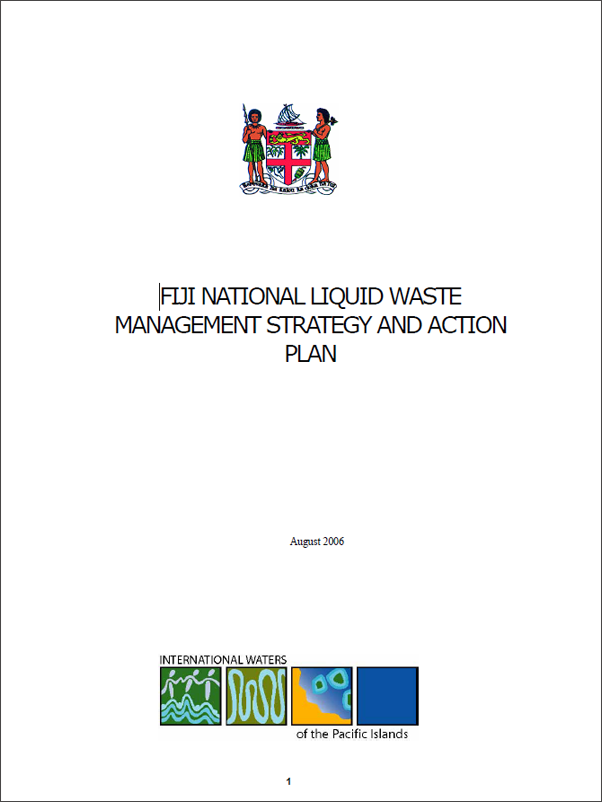
2006 | Department of Environment, Fiji
Keywords: National Liquid Waste mNangement Strategy
The recently passed Environmental Management Act (EMA) calls for the development of a National Liquid Waste Management Strategy. The National Solid Waste Management Strategy and Action Plan was developed in 2005. The proposed strategy will set the direction for sustainable liquid waste management in Fiji and was developed through a process of wide consultation with all stakeholders involved in the production and the management of liquid waste. The strategy developed will be led by Government working in close partnership with local government and other key stakeholders.
2010 | University of Cape Town
Keywords: Integrated solid waste management
Modern urban living generates a large variety of solid wastes that cannot be assimilated in the city environment. Nairobi is no exception, with each of its estimated 3.5 million residents generating approx. 600 g of solid waste every day. Large improvements in urban cleanliness and health were realized when organized collection of solid waste and its disposal outside of city limits were introduced in European cities in the late 19th century. In Nairobi, only half of the estimated 3000 ton of waste generated every day is collected. To prevent environmental degradation from the large dumpsites then arising, the practice of sanitary landfilling was invented, and more recently, it has been realized that state-of-the-art incinerators, whilst much more costly to operate, offer an even lower environmental footprint.
2010 | Global Islands Network
Keywords: National Solid Waste Management strategy
This is the Federated States of Micronesia National Solid Waste Management Strategy (NSWMS) which provides the strategic vision and direction for solid waste management over the five year period 2010-2014. The Strategy has been developed in consultation with key stakeholders from each of the four States, as well as the private sector, NGOs, communities, and municipal and national government representatives. The overall goal of this NSWMS is to develop, implement, and maintain a system of integrated solid waste management that deals with the solid waste stream and minimizes the negative impacts on the health of the population and environment of FSM.

2009 | unep
Keywords: Municipal Solid Waste
Regarding to the Natural Resources and Environmental Policy, the Government will implement an environment-friendly waste disposal system and enhance waste disposal capacity of local administrative authorities. The Government will also promote the private sector role in research and development for recycling of raw material and clean technology. In addition, the Government will not allow Thailand to become an end receiver of waste, which has to bear the costs of industrial waste and pollution.
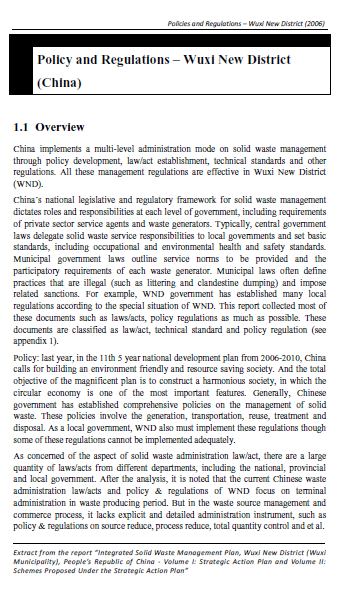
2009 | unep
Keywords: Policy Briefs
The following paragraphs describe the existing practices in the management system relating to WAB. The management system has been described based on generation based waste management system and stakeholder based waste management system.

2009 | unep
Keywords:
Regarding to the Natural Resources and Environmental Policy, the Government will implement an environment-friendly waste disposal system and enhance waste disposal capacity of local administrative authorities. The Government will also promote the private sector role in research and development for recycling of raw material and clean technology. In addition, the Government will not allow Thailand to become an end receiver of waste, which has to bear the costs of industrial waste and pollution.
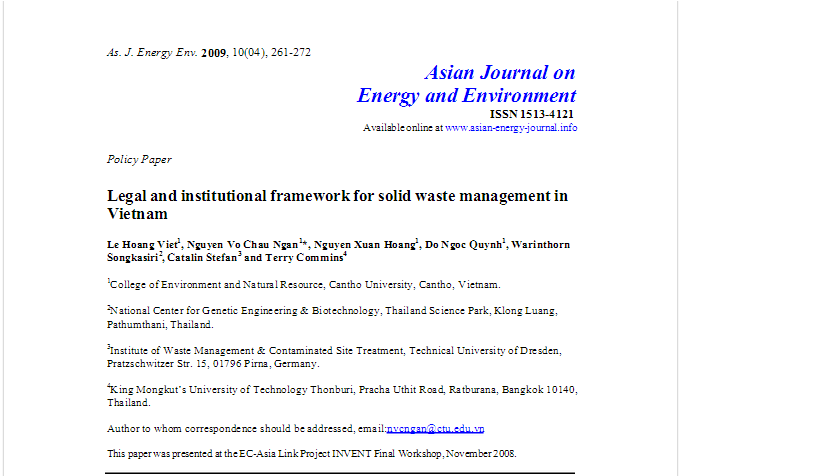
2009 | Asian Journal on Energy and Environment
Keywords: solid waste management, legal framework, Vietnam
In 1986, the Government of Vietnam launched a political and economic reform campaignnamed Doi Moi (Renovation) to guide the country from a centrally-planned economytowards a market economy. Since then, Vietnam has opened up its economy and has enteredthe process of trade liberalization. However, as a result of this rapid success in economicgrowth, there is a corresponding deterioration in the environment, particularly as a result of increased solid waste. In order to maximize the potential positive impacts but at the sametime minimize the negative effects of modernization and industrialization in the country, it isnecessary to take immediate measures to protect the environment.This paper describes how a legal and institutional framework for solid waste environmentalmanagement is being developed and implemented in Vietnam.
2009 | FAO
Keywords:
This Act aims at preventing and reducing volumes of waste generation, and at promoting the reuse, recycle and management of waste in an environmentally sound manner. Waste includes solid, liquid, gaseous, hazardous and non-hazardous, organic or inorganic waste from all kinds of sources and also the materials being stored for recycling and the transportation, import and export of waste. The Act empowers the National Environment Commission (NEC) to be the regulatory authority for waste prevention and management. The NEC shall also be responsible for coordinating and overseeing the implementation of the Act. The Act defines responsibilities of implementing agencies and of the public in managing the different categories of waste. It further provides for duties and responsibilities of implementing agencies and the different mechanisms used by them in managing waste including administrative, financial and research mechanisms. The Act further provides for funds financed by the Royal Government of Bhutan and for offences and penalties.
2007 | University of Cape Town / UNEP
Keywords: Integrated solid waste management
This document forms part of a series of documents prepared in the 2nd phase of the development of an Integrated Solid Waste Management Programme for Maseru, Lesotho. It focuses on gaps in policies and strategies, and also aims to comment on potential interventions. The document starts by providing a commentary on the relevant section of the Baseline Study. It proceeds to depict and discuss the policy tools and framework in which the ISWMP is developed. Next, the themes for the ISWMP are located in this institutional framework, and actors are identified for requisite actions. Finally, conclusions are presented. This document has been authored by the team of Associate Professor Harro von Blottnitz at the University of Cape Town, in terms of a contract for the United Nations Environment Programme.Purpose: Its purpose is to complement the relevant section of the Baseline Study (the main output of phase 1 of the project).ÂÂ
2007 | Ministry of Works and Human Settlement, Bhutan
Keywords:
AGENDA 21 Bhutan is one of the unique and advanced countries which implement the Sustainable Development Principles of the Agenda 21, formulated at the United Nations Conference on Environment and Development in Rio de Janeiro in 1992, and strongly reaffirmed at the World Summit on Sustainable Development held in Johannesburg in 2002. The Royal Government of Bhutan requested assistance for the formulation of a National Strategy on Integrated Solid Waste Management. The United Nations Environmental Program and the Regional Resource Centre for Asia and the Pacific provided support to the preparation of this document.
2006 | City of Melbourne
Keywords: Greenhouse Action Plan
This strategic framework implies that Council should seek to use as little energy as possible through energy efficient buildings, streetlights and other operations. Energy efficiency is the most financially attractive strategy; it saves money on energy bills. Secondly, the energy used should come from renewable sources (eg. Green Power, solar hot water), as much as practically and financially possible. Purchasing renewable energy drives investment in the renewable energy industry in Australia. Thirdly, the remaining emissions should be offset, when all else has been done through energy efficiency and renewable energy purchase or generation.

2006 | unep
Keywords: Sustainable development planning
China implements a multi-level administration mode on solid waste management through policy development, law/act establishment, technical standards and other regulations. All these management regulations are effective in Wuxi New District (WND). China national legislative and regulatory framework for solid waste management dictates roles and responsibilities at each level of government, including requirements of private sector service agents and waste generators. Typically, central government laws delegate solid waste service responsibilities to local governments and set basic standards, including occupational and environmental health and safety standards. Municipal government laws outline service norms to be provided and the participatory requirements of each waste generator. Municipal laws often define practices that are illegal (such as littering and clandestine dumping) and impose related sanctions. For example, WND government has established many local regulations according to the special situation of WND. This report collected most of these documents such as laws/acts, policy regulations as much as possible. These documents are classified as law/act, technical standard and policy regulation
2010 | SPREP
Keywords: Waste Management Strategy
This is the Pacific Islands region’s Strategy for solid waste management, setting the strategic direction for the period 2010-2015. It is supported by a highlevel implementation plan which sets out the key actions that will be taken to deliver the vision of the strategy. This Regional Solid Waste Management Strategy, 2010-2015 provides a framework within which to achieve the vision of “A healthy and a socially, economically and environmentally sustainable Pacific for future generations”, and the overall goal that Pacific Island Countries and Territories will adopt costeffective and self-sustaining Solid Waste Management systems to protect the environment, in order to promote a healthy population and encourage economic growth.
2007 | National Cleaner Production Centre
Keywords: Integrated solid waste management
City of Matale a small city in the Central province boasts a history dating back to over two millennia but today developing into a commercial and residential suburban city. The Municipal Council of Matale has faced similar problems like all other local government authorities in carrying out effective solid waste management to the satisfaction of the community. The Mayor of Matale and his elected representatives as well as the key Government officials are committed to make the city of Matale Clean & Green. Recognizing the commitment and the request for assistance by Matale Municipal Council (MMC), International Environmental Technology Centre(IETC) of United Nations Environmental Program (UNEP) in Japan decided to provide technical and financial assistance to develop a ISWM action plan for Matale. National Cleaner Production Centre, Sri Lanka an institute under UNIDO was identified as the local partner to provide technical assistance and serve as the local counterpart. The three partners enter into formal agreements and the project was launched in November with a awareness seminar and a training workshop.
2008 | Environment Research Centre, Ministry of Environment, Energy and Water
Keywords: National Solid Waste Management Policy
The National Solid Waste Management Policy is the product of the tireless efforts of a dedicated technical team that comprised a National policy Coordinator, International and local consultants, a Project Review Committee, the National Solid Waste Technical Committee, stakeholders in the private and public sectors as well as the staff of the Ministry of Environment, Energy and Water as represented by the Environment Research Centre.The frame work for the National Solid Waste Management Policy was developed with the assistance of the United Nations Development Programme that funded in 2004.
2021 | Ministry for the Environment, Newzealand
Keywords: waste management
This consultation document sets out proposals for a new national waste strategy and options for developing new, comprehensive waste legislation. The proposed waste strategy sets an innovative, bold direction to transform the way that we think about and manage waste. The options for new waste legislation support the transition to a more circular economy, and better regulate the management of waste and products and materials circulating in the economy.
2010 | Republic of Fiji
Keywords: National Solid Waste Management strategy
Fiji recognizes that waste management is a pressing issue that needs immediate action. It is recognized as a major concern with the potential to cause negative impacts on our national development activities including public health, the environment, food security, tourism and trade. To address these impacts, the National Solid Waste Management Strategy and Action Plan 2008-2010 was formulated and in the two years since the launching of the Strategy, there has been some progress on improving the management of solid waste. However, most solid waste is still currently being thrown in open dumpsites, illegally disposed off in the sea on unused land, or in the streets. Burning of municipal waste is also quite common, with the population being continuously exposed to the harmful health effects of carcinogenic toxins. This revised strategy, developed in consultation with stakeholders, strives to address the environmental, health, and economic impacts of wastes over the period 2011-2014, by building on the progress and successes achieved under the 2008-2010 strategy. It is supported by an implementation plan which sets out the key actions that will be taken to deliver the vision of the strategy.
2012 | Centre for Science and Environment
Keywords: Waste Management Policy
The Waste Prevention and Management Regulation, 2012, which came into effect on 18 April 2012 in Bhutan is a comprehensive regulation for the waste minimization and management. It establishes various agencies and monitoring authorities for the effective implementation of this regulation, and is applied to all point sources and/or point of origin of different types of waste and their management. National Environment Commission (NEC) is the apex monitoring body under this regulation which shall coordinate and monitor the overall performance of Implementing Agencies designated to efficiently implement the provisions of this Regulation. And, the Royal Bhutan Police shall assist the implementing agencies in achieving full compliance. This regulation is a strong measure to deal with the existing bad scenario of waste disposal and management in Bhutan.
| Department of Environmental Affairs, Republic of South Africa
Keywords: National Waste Management Strategy
This site is an initiative of the Department of Environmental Affairs (DEA). It is intended to provide an opportunity for members of the public, businesses, consumer groups, NGOs and other civil organisations to provide feedback and input into the National Waste Management Strategy (NWMS) as it is developed. Waste Management is one of the most significant challenges facing us as a country, and government is committed to tackling the problem effectively. Waste and pollution form a serious threat to human health and the integrity of the environment. Everyone has a role to play in waste management, and this is your opportunity to become informed on the topic and make your voice heard. The National Waste Management Strategy, as prescribed by the National Environmental Management: Waste Act, 2008 (Act no. 59 of 2008), has been drafted, gazetted and released for public comment. DEA would appreciate your comments on the strategy. Pls visit the site.
2003 | MINISTRY OF ENVIRONMENT AND FORESTS, New Delhi
Keywords: hazardous waste
The Gazette of India Extraordinary Part-II-Section-3-Sub-section (ii) Published by Authority No. 471New Delhi, Friday, May 23, 2003, MINISTRY OF ENVIRONMENT AND FORESTSNOTIFICATIONNEW DELHI, THE 20th May , 2003S.O. 593(E).-Whereas the draft of certain rules called the Hazardous Wastes (Management and Handling) Amendment Rules, 2002 was published under the notification of the Government of India in the Ministry of Environment and Forests number S.O. 553(E), dated 21st May, 2002 in the Gazette of India, Part-II, Section 3, Sub-section (ii) of the same date inviting objections and suggestions from all persons likely to be affected thereby, before theexpiry of the period of sixty days from the date on which copies of the Gazette containing the said notification were made available to the public;And whereas copies of the said Gazette were made available to the public on the 5th day of June, 2002.

2013 | Sage
Keywords: Decision support system, municipal solid waste, landfill design, barrier systems, computer application, leachate collection sys tem, geomembrane liner, clay liners
A decision support system (Landfill Advisor or LFAdvisor) was developed to integrate current knowledge of barrier systems into a computer application to assist in landfill design. The program was developed in Visual Basic and includes an integrated database to store information. LFAdvisor presents the choices available for each liner component (e.g. leachate collection system, geomembrane liner, clay liners) and provides advice on their suitability for different situations related to municipal solid waste landfills (e.g. final cover, base liner, lagoon liner). Unique to LFAdvisor, the service life of each engineered component is estimated based on results from the latest research. LFAdvisor considers the interactions between liner components, operating conditions, and the existing site environment. LFAdvisor can be used in the initial stage of design to give designers a good idea of what liner components will likely be required, while alerting them to issues that are likely to arise. A systems approach is taken to landfill design with the ultimate goal of maximising long-term performance and service life.
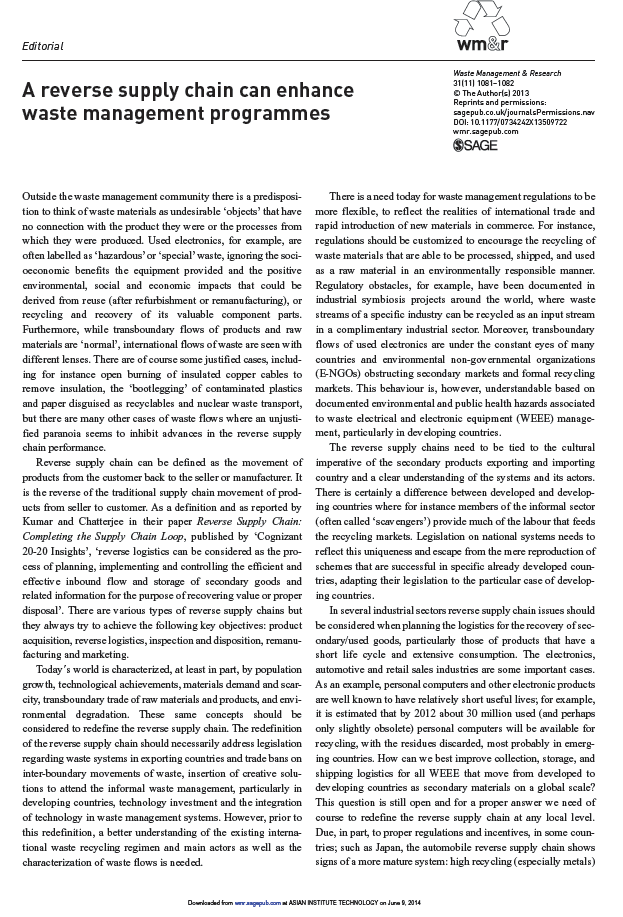
2013 | Sage
Keywords: reverse supply chain
Outside the waste management community there is a predisposi-tion to think of waste materials as undesirable objects that have no connection with the product they were or the processes from which they were produced. Used electronics, for example, are often labelled as hazardous or special waste, ignoring the soci-oeconomic benefits the equipment provided and the positive environmental, social and economic impacts that could be derived from reuse (after refurbishment or remanufacturing), or recycling and recovery of its valuable component parts. Furthermore, while transboundary flows of products and raw materials are normal, international flows of waste are seen with different lenses. There are of course some justified cases, includ-ing for instance open burning of insulated copper cables to remove insulation, the bootlegging of contaminated plastics and paper disguised as recyclables and nuclear waste transport, but there are many other cases of waste flows where an unjusti-fied paranoia seems to inhibit advances in the reverse supply chain performance.
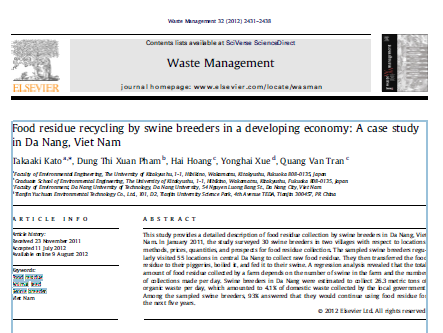
2012 | FacultyofEnvironmentalEngineering,TheUniversityofKitakyushu,1-1,Hibikino,Wakamatsu,Kitakyushu,Fukuoka808-0135,Japan
Keywords: Food residue, Animal feed, Swine breeder
This study provides a detailed description of food residue collection by swine breeders in Da Nang, Viet Nam. In January 2011, the study surveyed 30 swine breeders in two villages with respect to locations, methods, prices, quantities, and prospects for food residue collection. The sampled swine breeders regularly visited 55 locations in central Da Nang to collect raw food residue. They then transferred the food residue to their piggeries, boiled it, and fed it to their swine. A regression analysis revealed that the total amount of food residue collected by a farm depends on the number of swine in the farm and the number of collections made per day. Swine breeders in Da Nang were estimated to collect 26.3 metric tons of organic waste per day, which amounted to 4.1% of domestic waste collected by the local government. Among the sampled swine breeders, 93% answered that they would continue using food residue for the next five years.
2011 | UNESCAP
Keywords: waste collection, waste generation
Current solid waste management systems in Asia are strained, and landfill space is fast becoming a rare commodity. Governments face increasing costs for disposal, while public health and the environment suffer from the damaging effects of untreated solid waste. In 2009, the United Nations Economic and Social Commission for Asia and the Pacific embarked on a regional project, Pro-poor and Sustainable Solid Waste Management in Secondary Cities and Small Towns, to find appropriate approaches to waste management that would transform waste products into valuable resources, improve waste collection services and provide better income and working conditions for waste pickers.The overarching objective of the project is to enable participating towns to develop and execute solid waste management strategies that are decentralized, particularly benefit the urban poor, contribute to low-carbon development priorities and can be partly financed through the sale of carbon credits. Cambodia is one of the countries targeted in the project. Based on the outcomes of workshops and consultations with civil society groups, local government representatives and other United Nations organizations, Kampot town was selected for a baseline study, the first step in developing the pilot project. The study centred on collecting accurate information on solid waste management in Kampot.
2008 | Practical Action
Keywords: solid waste management
In fact solid waste management is a big challenge to all established and emerging towns of Nepal. Basically municipalities are giving preferences only on collecting the waste and dumping it. The principle of 3R (waste reduction, re-use and recycle) are not prioritised by the municipalities for effective sustainable waste management. Further, municipalities have not yet fully recognised the important stakeholders of waste management like NGOs/CBOs and private formal and informal sector which can be involved during the planning, implementation and monitoring for effective waste management. This book contains a range of best practices on solid waste management from various municipalities of Nepal. It also contains the admirable initiatives of national and local NGOs/CBOs. I hope that this book will be highly instrumental regarding solid waste management to urban centres as well as emerging towns of developing countries.
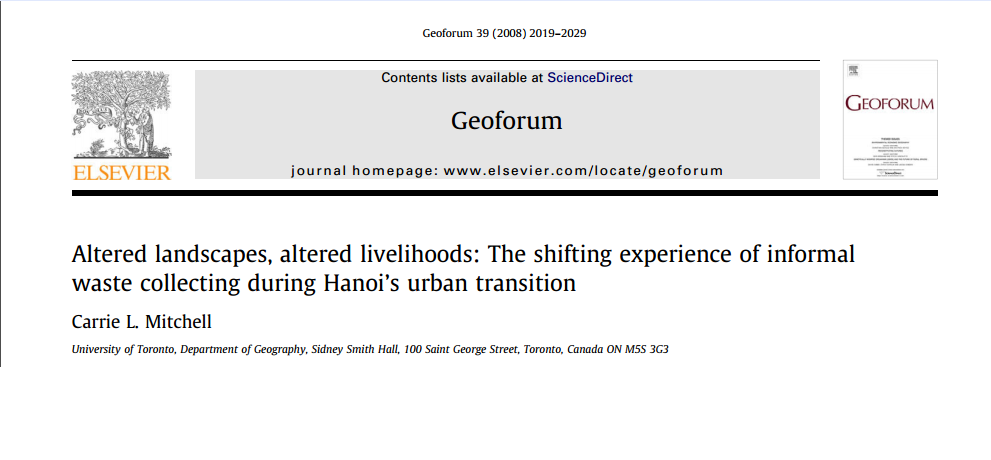
2008 | Elsevier
Keywords: Waste pickers, Junk buyers, Urbanization Gender
A growing body of literature is concerned with urbanization processes in contemporary Vietnam and how the country globalizing cities of Hanoi and Ho Chi Minh City are increasingly becoming spaces of consumption. However, much less is known about how these changing spaces accommodate labour, and in turn support livelihoods. Using published empirical data on Hanoi informal waste collectors from 1992 and my own data, including a survey of 575 waste collectors and 44 interviews, collected on Hanoi informal waste collectors in 2006, I explore the experiences of informal waste collectors (waste pickers and itinerant junk buyers) in Vietnam capital city of Hanoi. I argue that Vietnam globalizing economy and urban transition have been a catalyst for the growth of the informal waste collector population in Hanoi as well as a partial player in the gendering of this group and the work they undertake.
2008 | Elsevier
Keywords: Municipal solid waste management, Greenhouse gas
The environmental impacts of municipal solid waste (MSW) management have been highlighted in China, due to the continually increasing amount of MSW being generated and the limited capacity of waste treatment facilities. Of particular interest is greenhouse gas (GHG) mitigation, aided by the Kyoto Mechanisms. China is an important case study for this global issue; however, an analysis of the entire life cycle of MSW management on GHG emissions is not available for China. This study evaluates the current and possible patterns of MSW management with regard to GHG emissions, using life cycle assessment (LCA), based on the Tianjin case. We assess the baseline scenario, reflecting the existing MSW management system, as well as a set of alternative scenarios, five exploring waste treatment technology innovations and one exploring integrated MSW management, to quantitatively predict potentials of GHG mitigation for Tianjin.
2007 | Asian Productivity Organization
Keywords:
Solid-waste management is a major challenge in urban areas throughout the world. Without an effective and efficient solid-waste management program, the waste generated from various human activities, both industrial and domestic, can result in health hazards and have a negative impact on the environment. Understanding the waste generated, the availability of resources, and the environmental conditions of a particular society are important to developing an appropriate waste-management system.
1998 | BANGLADESH CENTRE FOR ADVANCED STUDIES
Keywords:
It was World War II that placed plastics at the center of necessity. A rubber substitute called vinyl was used by Allied troops for waterproof tents and boots. An ultra-light insulation -polyethylene gave the British the ability to install radar on planes and ships and a critical advantage over the otherwise superior German Air Force and Navy. By 1979, plastic production surpassed that of steel, ushering in what Stephen Fenichell, author of Plastic: The Making of a Synthetic Century, calls the Plastic Age, a title as indicative of human progress as the Iron Age or the Bronze Age. Long-lasting super plastics are fast replacing metal in buildings, machines, and vehicles.
1994 | Ashoka Innovators for the public
Keywords:
In early 1994, two young Urban Planners completing their graduate studies approached a government official in the Dhaka City Corporation (DCC) with their concerns about the growing problem of solid waste in their city. They outlined their ideas for solving the problem, which included getting communities involved in composting their organic waste. The pair even offered to donate their time to the municipal body and to other gover nment agencies to make this a reality. Unconvinced, the official challenged them saying, "If community-based compost plants are such a great idea why don't you do it yourselves?"

2017 | AIT RRC.AP
Keywords: solid waste management
The UWMISAP is divided into five chapters. The first chapter provides a background for the need for a city waste management strategy for Ulaanbaatar and outlines the process of developing a strategy and action plan. The existing situation of Ulaanbaatar’s solid waste generation as well as waste handling and legal framework are discussed in Chapter 2. Based on the baseline information provided in Chapter 2, a list of strategies to fill existing gaps and tap potential opportunities is described in Chapter 3. Chapter 4 presents specific actions to be accomplished under each strategic objective. Chapter 5 concludes with arrangements for implementing and monitoring the UWMISAP.

2017 | AIT RRC.AP
Keywords: solid waste management
The NWMISAP is arranged into five chapters. The first chapter provides the background for the need of a waste management strategy, the existing situation of waste management in Mongolia and the current policy and legal framework. Chapter Two describes the strategy development process. Based on this baseline information, a list of strategies to fill the existing gaps and tap the potential opportunities are laid out in the third chapter. Translating these strategic objectives into actions is presented in Chapter Four. The fifth chapter concludes with arrangements for implementation and monitoring of the NWMISAP.
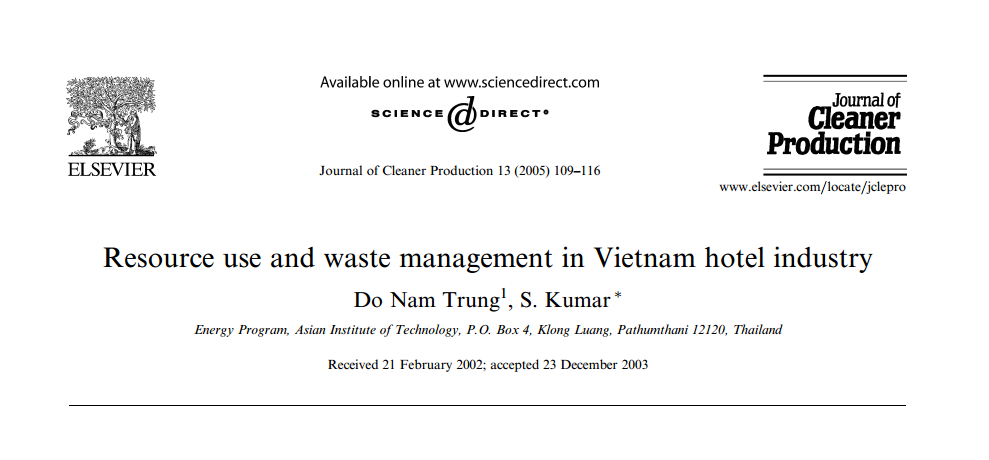
2005 | Elsevier
Keywords: Hotel energy consumption, Hotel water use, Hotel waste, Hotel industry, environmental performance
The hotel industry of Vietnam is expanding rapidly with increasing international arrivals and domestic tourists. At the same time, mounting costs of resources and impacts of waste could affect the income, environmental performance and public image of the hotel sector. The hotel industry resource management (energy and water) would contribute to the long-term sustainability of the tourism sector. This paper reports the results of a study conducted to assess the resource use and management in the hotel industry in Vietnam. This was obtained by carrying out a survey in 50 hotels on energy and water consumption, and waste generation. The energy and water use, as well as the waste generated in the various hotel categories have been estimated and compared with those in other countries. The current practices in the hotels to address these issues are highlighted, and benchmarks for efficient use of resources in Vietnamese hotels are presented.
2004 | UNEP
Keywords: Environment Outlook
The Pacific Environment Outlookwas prepared simultaneously with the Pacific Regional Assessment on SustainableDevelopment to feed into the Barbados +10 process and ensure consistency of much of reporting.Much of theinformation has been drawn from national and regional reporting to the World Summit on Sustainable Development(WSSD), preparations for the Barbados +10,and from key reports for international and regional multilateralenvironmental agreements.The Pacific Environment Outlookpresents environmental trends by assimilating the drivers that directly and indirectlyaffect the state of the environment.It examines the linkages between social and economic activities and theenvironment in the Pacific SIDS,highlighting their social,economic and environmental vulnerability.The use of nationalassessment reports for the Barbados +10 has enabled the portrayal of national and regional priorities in terms ofthematic environmental issues and cross-cutting institutional capacity needs.
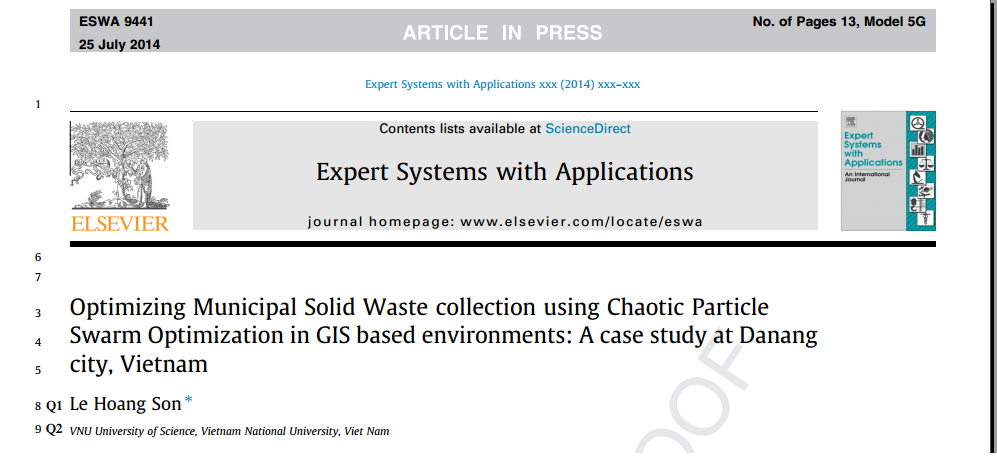
2014 | Elsevier
Keywords: ArcGIS, Chaotic Particle, Swarm Optimization, Vehicle routing model, Heuristic algorithms, Municipal Solid Waste collection
Municipal Solid Waste (MSW) is an increasing concern at any municipality in the world, and is one of the primary factors that contribute greatly to the rising of climate change and global warming. MSW collection and disposal especially in the context of developing countries are indeed the urgent requirements for the sustainable development of environment and landscape, which rule over the quality-of-life and life expectancy of human being. In this paper, we concentrate on MSW collection at Danang city, which is one of four largest municipalities in Vietnam having high quantity of the average waste load per person and is bearing negative impacts of climate change such as severe weather conditions and natural disasters as a result. A novel vehicle routing model for the MSW collection problem at Danang city is presented. A novel hybrid method between Chaotic Particle Swarm Optimization and ArcGIS is proposed to generate optimal solutions from the vehicle routing model of Danang. Experimental results on the real dataset of Danang show that the proposed hybrid method obtains better total collected waste quantity than the relevant ones including the manual MSW collection procedure that is currently applied at this city.
2014 | Sage
Keywords: waste future
Future waste" is a term not yet established in the waste community; actually it is a paradoxon. Future waste" is not dealing with current solid waste, but products that will become waste in the future. Due to advances in science and technology and priorities in politics, large quantities of these, often technologically complex, products have already entered the anthropogenic stock within a short period of time or are about to do so in the near future. As the majority of these items have relatively long life spans they will not immediately play an important role in waste management, however, once the product life time is over meaningful quantities of this future waste" will be generated. At that time we need to have appropriate waste management solutions available as these wastes: (1) contain valuable resources (e.g. precious metals and critical raw materials, usually in very low concentrations) and (2) pose specific new challenges to prevent hazards associated with their treatment (e.g. nano-materials).
2013 | United Nations Environment Programme
Keywords:
The statistics are stark: 3.5 billion people, or half of the world population, are without access to waste management services, and open dumping remains the prevalent waste-disposal method in most low- and lower middle- Income countries. More than 1.3 billion tonnes of municipal solid waste were estimated to have been generated in 2012 and 2.2 billion tonnes a year are expected by 2025. Urbanization, industrialization, increasing population and economic development are all contributing to the rise in waste and also to its increasing complexity and hazardousness.
2013 | UNCRD
Keywords: country analysis report on 3R
Rapid growth of economic urbanization and industrial development are the cause of more concerns within solid waste management. In this regard, the Ministry of Environment is the institution responsible for protecting the environment and human health has developed the guidelines as well as related orders to solve the problems and enhance environmental quality in Cambodia that include: the development of legal instruments and related regulations. Refer to annual report conducted by Department of Pollution Control, solid waste collection and disposal at dumping sites in cities and districts is about 933,144 tones with increasing rate amount 10\% every year.
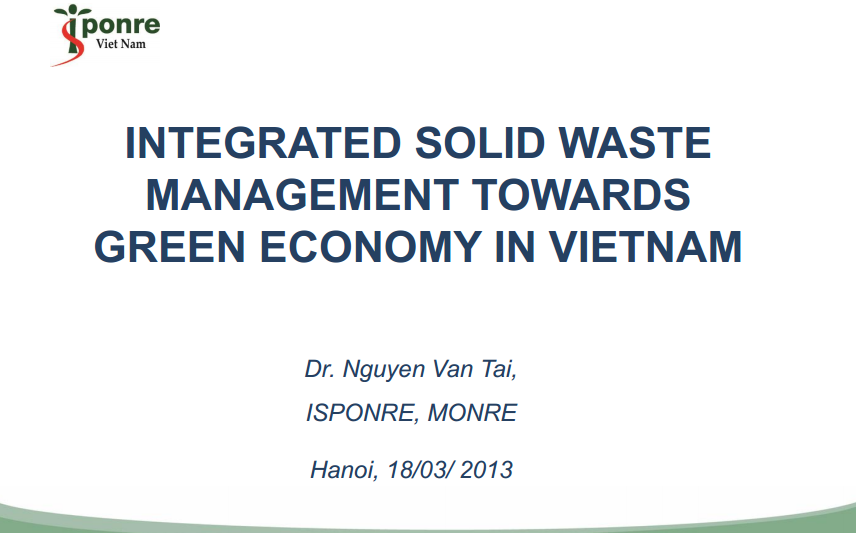
2013 | Vietnam Ministry of resources and environment
Keywords:
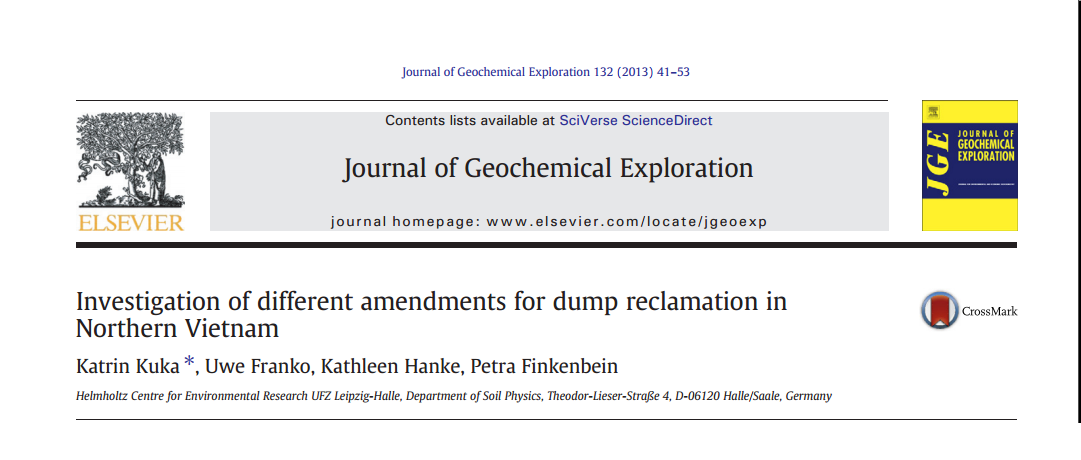
2013 | Elsevier
Keywords: Dump, landfill, restoration, Charred rice straw (biochar), Power station, ash, Lignite
Giant spoil dumps originate in the course of open-cast mining. The initial properties of Triassic spoil as well as pedogenesis are characterized by weathering processes. Due to the poor conditions in dump spoil a natural succession of plants or a re-vegetation is a lengthy process. The Chinh Bac field experiment (Ha Long City, Quang Ninh province, Vietnam) was planned to investigate the possible impacts of three amendments charred rice straw, power station ashes and fine material originating from the mining area in combination with sieved spoil of substrate quality to enhance plant growth. The main focus of this study was directed towards the impact of added amendments on spoil chemical parameters. The investigations demonstrated that simply sieving the spoil leads to better substrate conditions. It increases the fine material which in turn leads to easier plantation conditions. At the same time oxidative processes and leaching acid products are stimulated which raises the pH values afterwards.
2013 | Sage
Keywords: landfill, gas-to-energy
Open dumps employed for disposal of municipal solid waste (MSW) are generally referred to as landfills and have been traditionally used as the ultimate disposal method in India. The deposition of MSW in open dumps eventually leads to uncontrolled emission of landfill gas (LFG). This article reviews the MSW disposal practices and LFG emissions from landfills in India during the period 1994 to 2011. The worldwide trend of feasibility of LFG to energy recovery projects and recent studies in India indicate a changed perception of landfills as a source of energy. However, facilitating the implementation of LFG to energy involves a number of challenges in terms of technology, developing a standardized framework and availability of financial incentives. The legislative framework for promotion of LFG to energy projects in India has been reviewed and a comprehensive strategy and action plan for gainful LFG recovery is suggested. It is concluded that the market for LFG to energy projects is not mature in India. There are no on-ground case studies to demonstrate the feasibility of LFG to energy applications. Future research therefore should aim at LFG emission modeling studies at regional level and based on the results, pilot studies may be conducted for the potential sites in the country to establish LFG to energy recovery potential from these landfills.
2012 | Journal of Applied Sciences
Keywords: Integrated solid waste management, contingent valuation method
Solid Waste Management (SWM) is a critical issue in Kota Bharu, a compacted city in east coast of West Malaysia. The amalgamation of dwindling financial resources and population growth results in incompetency in controlling and handling excessive solid waste generation, giving rise to adverse effects on environment and public health. This study was attempted to evaluate acceptance of the communities towards introducing Integrated Solid Waste Management (ISWM) to alleviate the drawbacks of current solid waste management. Single-bounded Dichotomous Contingent Valuation Method (DC-CVM) was conducted to estimate communities Willingness to Pay (WTP). Primary data obtained through personal interview were analyzed using a logit model.
2011 | Provincial Government of Western Cape
Keywords: Industry Waste Management Plan
The purpose of this guideline is to provide industry with assistance and guidance with respect to the development of their industry in WMPs using the Industry Waste Management Plan Guideline. Furthermore, the assessment checklist, that will be used by the DEA&DP for evaluation of the submitted Industry WMPs, is also attached for self-assessment by industry.
2011 | UNCRD
Keywords: organic waste, plastic waste
Bhutan is a small landlocked country in the Eastern Himalayas bordered by China in the North and India on the other 3 sides. Bhutan has a population of 695,822 in the year 20101 with total land area of 38,394 square. The landscape is characterized by rugged terrain and steep mountain valleys ranging from 150meters in the sub- tropical valleys in the southern foothills, through temperate zone to heights exceeding 7000 meters in the alpine regions of the mountains.
2011 | ADB
Keywords: organic waste
Description"This report provides a clear and up-to-date guide for harnessing the huge resource recovery potential of organic waste in the region, and is a practical reference for any policy maker or practitioner working to improve the livability of cities. Dr. Masaru Tanaka, President, Society of Solid Waste Management Experts in Asia and Pacific IslandsThe massive scale of urbanization in South Asia is expected to create a surge in demand for solid waste services.
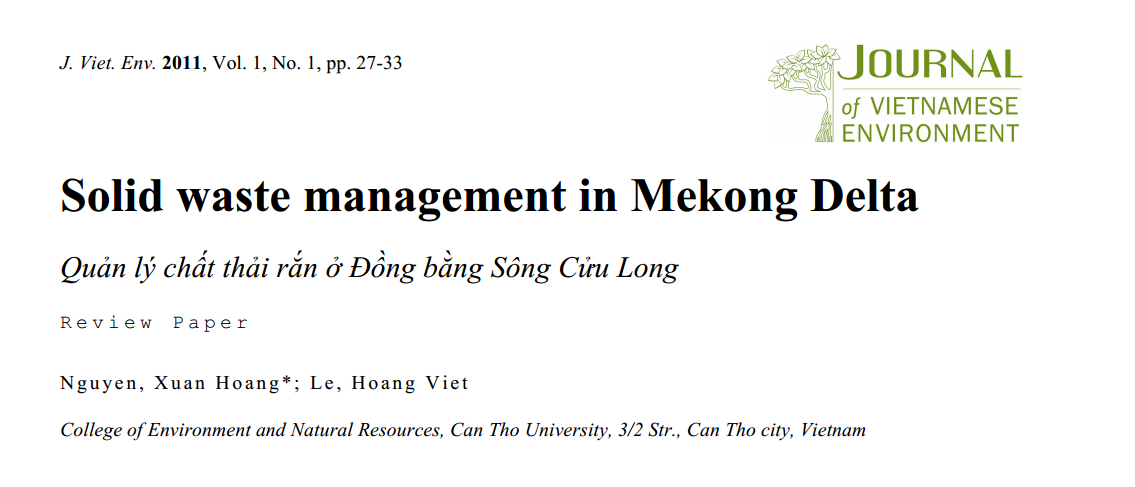
2011 | Journal of Vietnamese Environment
Keywords: Integrated Solid Waste Management management, waste collection, disposal, Mekong Delta
Integrated Solid Waste Management (MSW) in Vietnam has been increasing quickly and became one of the most considered environmental problems in Mekong Delta (MD) region covering 13 provinces and municipalities in the south of Vietnam. With a considerably large amount of MSW, the region produces about 5\% of the total amount of MSW of the country. The collection rate of solid waste is about quite high (65 - 72\%) in the cities and rather low (about 40 - 55\%) in the rural areas, with a high content in organic matter (about 60 - 85\%). The climate of MD can be characterized as tropical and monsoonal with a high rate of humidity and a strong impact of flooding. Like other regions too, the MSW collection and treatment system is still underdeveloped and rudimentary, with disposal sites being the sole dumping method of the unsorted MSW remaining untreated by any me-chanical and biological pre-treatment steps. Within this paper, the current treatment, management and operation of MSW systems are introduced, as well as the identification of advantages and dis-advantages, environmental impacts, potential risks of the MSW system within the impact of global climate change.
2010 | 1 The Department of Urban Development & Engineering Services, Ministry of Works & Human Settlements, Thimphu, Bhutan
Keywords: waste generation, household wastes, waste characterisation
Bhutan is a small landlocked country located in the eastern Himalaya between Tibet-China (in the North) and India (in the east, south and west). Its total population in 2005 was 672,425 (PHCB, 2006) and it has a total area of 38,394 km2 (MoA 2004). Like any other developing country, Bhutan too is facing the challenges of rapid urbanisation with more than 30\% of the country population living in the urban areas which is expected to increase in the next few decades. Although the national annual population growth rate in Bhutan is 1.28\% (MoWHS 2007, PHCB, 2006), its average urban population growth rate has been reported to be 7.3\% annually with the western region, including Thimphu, experiencing maximum growth rate of about 11\% (MoWHS 2007). Thimphu is the capital city of Bhutan with a total population of 79,185 (PHCB, 2006) in 2005 which is more than 40\% of the entire urban population in Bhutan.
2010 | UNDP
Keywords: Publich-Private Partnership
Urbanization in Bhutan has taken place at a rapid pace over the last 10 years or so. By 2005, the proportion of Bhutanese urban population had grown to 31 percent. It is projected that by 2020 half of the Bhutanese population will be living in urban areas. Burgeoning urban population has created several environmental problems such as air and water pollution, water shortage, increase of municipal waste volumes and types, congestion of traffic and buildings, and land degradation. The Thimphu Municipality has not yet developed any standard and effective strategy for waste management at the household and community levels.
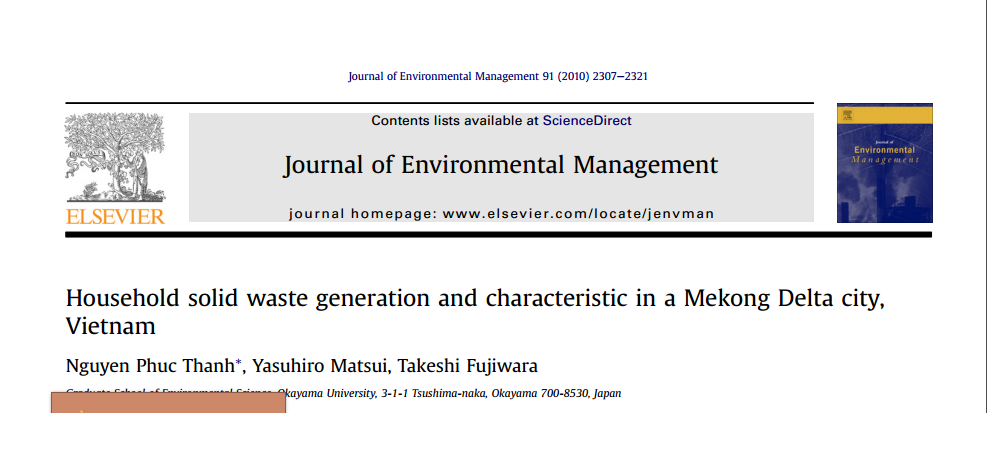
2010 | Elsevier
Keywords: Municipal solid waste Waste, recycling, Composting, Food waste, waste generation
The household waste (HW) constitutes an important fraction in municipal solid waste (MSW). The composition of HW is an important factor in design an effective solid waste management plan for city. The aim of study was to estimate the quantity and quality of HW in terms of socio-economic groups and family size in the Dehradun city, India. A total of 144 households were selected from 11 major blocks of the city and HW quantification and characterization was analyzed for different blocks/colonies.
2010 | Elsevier
Keywords: Household solid waste (HSW), Waste composition, analysis Waste generation, rate Compostable waste, Recyclable waste, Correlation analysis
This study was undertaken to evaluate the quantity and composition of household solid waste to identify opportunities for waste recycling in Can Tho city, the capital city of the Mekong Delta region in southern Vietnam. Two-stage survey of 100 households was conducted for dry season and rainy season in 2009. Household solid waste was collected from each household and classified into 10 physical categories and 83 subcategories. The average household solid waste generation rate was 285.28 g per capita per day.
2010 | Research Journal of Environmental Sciences, 4: 209-222
Keywords: People's participation, solid waste
The purpose of this study was to explore implementation strategies for fostering people participation in solid waste management in Myanmar. To achieve this, an action research employing mixed methods was conducted in Bagan City, within the twenty months period. Household attitudes and behavior was collected through questionnaire surveys. In-depth interview, group discussion, organizational and community meetings and observation were conducted to address problem situations, explore strategies to fix the problems and assess the outcomes.

2009 | UNEP
Keywords: Awareness
Madhyapur Thimi Municipality (MTM) is one of the highest urbanizing towns. It is located in the district of Bhaktapur in Bagmati Zone, Central Development Region of Nepal. Madhyapur Thimi got its municipality status only in 1996 (B.S. 2053). Five Village Development Committees namely Bode, Chapacho, Balkumari, Dibyaswori and Nagadesh prior to this declaration were amalgamated to form this municipality.

2009 | unep
Keywords: Municipal Solid Waste, Multimedia
Globally, 140 billion metric tons of biomass1 is generated every year from agriculture. This volume of biomass can be converted to an enormous amount of energy and raw materials. Equivalent to approximately 50 billion tons of oil2, agricultural biomass waste converted to energy can substantially displace fossil fuel, reduce emissions of greenhouse gases and provide renewable energy to some 1.6 billion people in developing countries, which still lack access to electricity3. As raw materials, biomass wastes have attractive potentials for large-scale industries and community-level enterprises. Biomass takes the form of residual stalks, straw, leaves, roots, husk, nut or seed shells, waste wood and animal husbandry waste. Widely available, renewable, and virtually free, waste biomass is an important resource. With the global campaign to combat climate change, countries are now looking for alternative sources of energy to minimize green house gas (GHG) emissions. Aside from being carbon neutral, the use of biomass for energy reduces dependency on the consumption of fossil fuel; hence, contributing to energy security and climate change mitigation.
2009 | UNEP
Keywords: Integrated solid waste management
Thes books are in the series of training manuals on developing Integrated Solid Waste Management (ISWM) plan. This manual aims to build the capacity of practitioners and policy makers in waste characterization and quantifiÂÂcation with projections for future for all the waste generating sectors viz.: residential, commercial, construction and demolition, healthcare and industrial sectors.
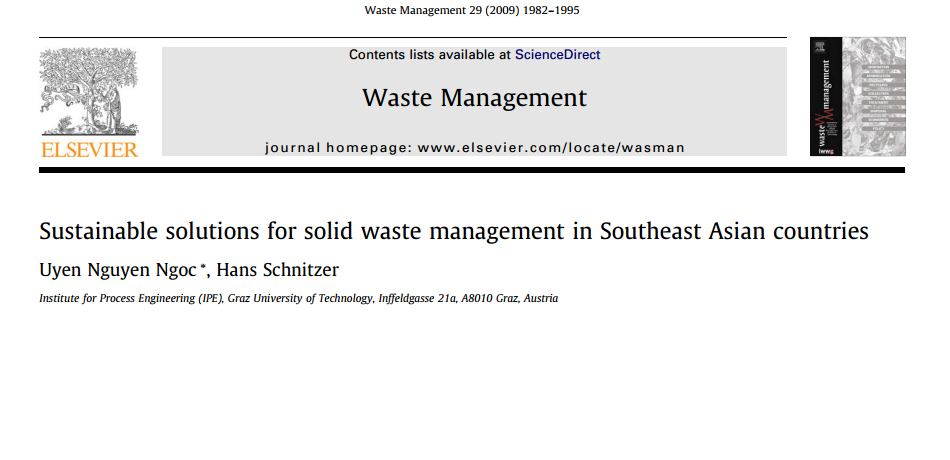
2009 | Elsevier
Keywords: solid waste management
Human activities generate waste and the amounts tend to increase as the demand for quality of life increases. Today rate in the Southeast Asian Nations (ASEANs) is alarming, posing a challenge to governments regarding environmental pollution in the recent years. The expectation is that eventually waste treatment and waste prevention approaches will develop towards sustainable waste management solutions. This expectation is for instance reflected in the term zero emission systems.

2009 | Vietnam Environment Administration
Keywords:
2009 | Cambodian Institute for Cooperation and Peace
Keywords:
Solid waste management consists of two sectors: the formal operation and the informal scavenging activities. Because scavenging contributes to solid waste management economically and environmentally and also serves as an occupation for some of the most impoverished in the city, recently it has become the focus of scholarly deliberation. A notion of integrating this informal sector of SWM into the formal one is proposed by different scholars. Though they appear to differ in terms of approaches and arguments, their proposed policies are place-based. This paper examines the situations of solid waste management, both the formal and the informal, in Phnom Penh city, and discusses the feasibility of integrating the informal scavenging into the formal management of solid waste. It raises questions about the possible unintended consequences when informal scavenging is integrated through such place-based approach.
2009 | Elsevier
Keywords: solid waste management
Human activities generate waste and the amounts tend to increase as the demand for quality of life increases. Today's rate in the Southeast Asian Nations (ASEANs) is alarming, posing a challenge to governments regarding environmental pollution in the recent years. The expectation is that eventually waste treatment and waste prevention approaches will develop towards sustainable waste management solutions. This expectation is for instance reflected in the term 'zero emission systems'. The concept of zero emissions can be applied successfully with today's technical possibilities in the agro-based processing industry.
2008 | WaterAid
Keywords: solid waste management
This paper reflects the existing management systems practiced in various areas of Nepal in managing solid waste and contains initiatives of municipalities; national and local NGOs/CBOs; public and private entities. This paper helps to transfer the lessons and existing practices regarding soild waste managment and encourages urban, peri urban and emerging towns for similar initiatives in urban sanitation.

2008 | UNEP
Keywords: Institutional
Phnom Penh Municipality (PPM) is the capital city of the Royal Kingdom of Cambodia with a total land area of 376.95 Km2. It is equal to 0.20\% of the total land area of the country. Administratively, PPM is divided into 7 districts (up to 2008) but now one more district has been determined, 76 communes, 689 villages and 4,320 groups. The population of the city is approximately 1,080,519 consisting of 188,769 households out of which 43\% live in urban area and 57\% in rural area. Population growth in the city is 3.92\%.
2008 | Elsevier
Keywords: challenge climate change
Currently the potential threat of climate change represents one of the main environmental concerns worldwide. Consequently, most of the developed countries are implementing measures at different levels in order to tackle greenhouse gas (GHG) emissions. Amongst the measures agreed internationally and encapsulated within the Kyoto Protocol, the reduction of GHG emissions associated with agriculture and organic waste management, and the enhancement of the C sink capacity of agricultural soils are seen to be of particular importance.
2007 | UNEP
Keywords: stakeholders consultation, integrated waste management
Pune Municipal Corporation (PMC) and International Environmental Technology Centre (IETC) of the United Nations Environment Programme (UNEP) are in the process of formulating the Integrated Solid Waste Management (ISWM) Plan for Pune. The Plan for Pune has been developed using the Strategic Planning Process. This Report for the ISWM project for Pune city aims to present the summary of the Stakeholders' consultative workshops held to facilitate the planning process.
2007 | UNEP
Keywords: Integrated Solid Waste Management
The Schemes for Strategic Action Plan were generated to support the goals and objectives. In order to categorise the Schemes at operational level, five themes were identified based on the functional nature. These themes include,Assessment and Development3R InitiativesInfrastructure DevelopmentAwareness and PromotionCapacity Building and Partnerships.

2006 | unep
Keywords:
Pune is the second largest city in Maharashtra and 8th in country. As per the Census 2001 the population of the city is 2.7 million. The reported average population density as per the 2001 census was 11500 persons per Sq. Km. However the city urban body, Pune Municipal Corporation (PMC), estimated the population to have grown to about 3 million in the year 2006, with the population density of 13200 persons per Sq. Km. This effectively means a phenomenal increase of 11\% in terms of population in 5 years.
2006 |
Keywords: Household Waste composting
Sixty percent of around 2,900 tones/day MSW in Sri Lanka is collected in the Western Province while 43\% and 25\% in Colombo District and Colombo Municipal limits, respectively. Furthermore, though legal responsibility is with local authorities, no proper execution is observed in most cases.
2006 | Elsevier
Keywords: recycle, Waste management
Many thousands of people in developing country cities depend on recycling materials from waste for their livelihoods. With the focus of the Millennium Development Goals on poverty reduction, and of waste strategies on improving recycling rates, one of the major challenges in solid waste management in developing countries is how best to work with this informal sector to improve their livelihoods, working conditions and efficiency in recycling.
2005 | WORLD BANK
Keywords:
ABSTRACTThe development objective of the Municipal Infrastructure Development Project for Tajikistan is to improve the availability, quality and efficiency of delivery of basic municipal services to the population of the towns which participate in the project. This Paper seeks the approval of the Country Director for a second level restructuring to extend the closing date of the project. The implementation performance and the outcome outlook of the project are satisfactory.
2005 | Elsevier
Keywords: solid waste management
Though the solid waste management (SWM) system in Phnom Penh city in general has been upgraded since the waste collection service was franchised out to the private sector, the performance of the existing SWM system is still low. Unreliable and irregular collection service still exists. This means that there are shortcomings in the existing SWM system that need correction. This paper is an attempt to identify those shortcomings in order to end ways to improve the existing system. First, the present SWM system is reviewed.
2004 | His Majesty's Government, Nepal
Keywords: solid waste management
Dharan is a mid-sized municipality located in Sunsari distict, Koshi zone of the Eastern Development Region. It was established in 2017 BS. Dharan is one of the fastest growing cities in the nation and a major urban centre of eastern Nepal. Dharan lies on the southern slope of Mahabharat mountain range immediately north of the Charkoshe Jungle and the terai. The municipality is bordered by Pancha kanya VDC in the east, Bishnupaduka VDC in the west, Vedetar VDC and Panchkanya VDc in the north and Charkoshe Jhadi in the south. With the establishment of the B. P. Koirala Teaching Hospital, Dharan is becoming a centre for education and health facilities.
| Dr Anwar Baig
Keywords:
Municipal Solid Waste Generation and its Disposal Practices in Pakistan:BY Dr. Muhammad Anwar BaigInstitute of Environmental Science & Engineering (IESE)National University of Sciences & Technology (NUST) Solid waste can be defined as material that no longer has any value to the person who is responsible for it, and is not intended to be discharged through a pipe. It is generated by domestic, commercial, industrial, healthcare, agricultural and mineral extraction activities and accumulates in streets and public places. The words "garbage"ÂÂ, "trash"ÂÂ, "refuse" and "rubbish" are used to refer to some forms of solid waste.
2010 | Ministry of Environment, Science and Technology
Keywords: Waste management
Waste Management Initiatives and Challenges of NepalPresented by Dr.Chhewang Lama(Sherpa)Ministry of Environment, Science and Technology, Nepal.Policy and legal initiatives in solid waste management encompass current approach and practices. Quantity and types of waste generation along with 3R approach in management system pave way for Public, Private Partnership approach addressing certain challenges.
2010 | Kathmandu Metropolitan City
Keywords: solid waste management
Generation & Collection of KMC: Waste Generation is 0.3 kg/p/day making a total domestic waste gen. App. 246 ton/day and others: Commercial waste (12\%)app. 30 ton/day; Street Waste (12\%) app. 30 ton/day; Waste from VDC (12\%) 30 ton/day. Total Generation: 335 ton/day; Collection 306 ton/day; About 70\% waste are organic. Municipalities are completely responsible. Some new approaches are being tried out in KMC: Door-to-door collection, User fees, Source-separated collection, Composting, and Private sector participation.
2006 | Ministry of Environment of Cambodia and COMPED-Cambodian Education and waste Management Organization
Keywords:
Now with the economic development and increasing people the requirement using equipment for their every day living is increased too, these are the reasons of the environmental issue and because of the people through out their solid waste around the country (provinces and cities) that it is negatively effect to the public health and environment. By understanding of this issue, the Royal of Cambodian government has cared and put out some measures as: preparing regulations for ensuring proper solid waste management with environmental safety, capacity building of skill staffs, educating people to understand the negative effectiveness of waste that will happen to themselves, the proper way of waste disposal with environmental sanitation and encouraging the involved institutions and private companies to behave regulations. This environmental guideline has been gotten by trying very hard of Ministry of Environment and COMPED organization partner, this environmental guideline on Solid Waste Management in Royal Cambodia is fully detail that can be encouraged to behave the ready prepared regulations and it is an important base to help the involved institutions especially province-city authorities and private sectors to improve their Solid Waste Management which is facing the problems and make it better in the future.